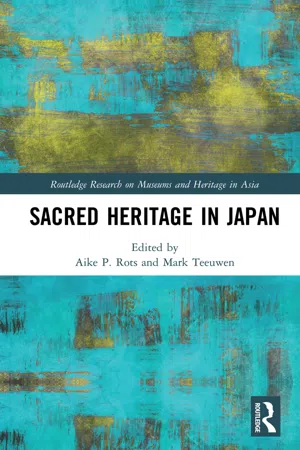
- 210 pages
- English
- ePUB (mobile friendly)
- Available on iOS & Android
Sacred Heritage in Japan
About this book
Sacred Heritage in Japan is the first volume to explicitly address the topics of Japanese religion and heritage preservation in connection with each other.
The book examines what happens when places of worship and ritual practices are rebranded as national culture. It also considers the impact of being designated tangible or intangible cultural properties and, more recently, as UNESCO World or Intangible Heritage. Drawing on primary ethnographic and historical research, the contributions to this volume show the variety of ways in which different actors have contributed to, negotiated, and at times resisted the transformation of religious traditions into heritage. They analyse the conflicts that emerge about questions of signification and authority during these processes of transformation. The book provides important new perspectives on the local implications of UNESCO listings in the Japanese context and showcases the diversity of "sacred heritage" in present-day Japan.
Combining perspectives from heritage studies, Japanese studies, religious studies, history, and social anthropology, the volume will be of interest to scholars and students who want to learn more about the diversity of local responses to heritage conservation in non-Western societies. It will also be of interest to scholars and students engaged in the study of Japanese religion, society, or cultural policies.
Frequently asked questions
- Essential is ideal for learners and professionals who enjoy exploring a wide range of subjects. Access the Essential Library with 800,000+ trusted titles and best-sellers across business, personal growth, and the humanities. Includes unlimited reading time and Standard Read Aloud voice.
- Complete: Perfect for advanced learners and researchers needing full, unrestricted access. Unlock 1.4M+ books across hundreds of subjects, including academic and specialized titles. The Complete Plan also includes advanced features like Premium Read Aloud and Research Assistant.
Please note we cannot support devices running on iOS 13 and Android 7 or earlier. Learn more about using the app.
Information
Table of contents
- Cover
- Half Title
- Series Information
- Title Page
- Copyright Page
- Table of Contents
- Figures
- Contributors
- Acknowledgements
- Abbreviations
- Chapter 1 Heritage-making and the transformation of religion in modern Japan
- Chapter 2 The politics of Japan’s use of World Heritage: From ratifying the World Heritage Convention to the Mozu–Furuichi Tumulus Clusters
- Chapter 3 An introduction to multilateral heritage politics: Japan and the World Heritage Convention
- Chapter 4 World Cultural Heritage and women’s exclusion from sacred sites in Japan
- Chapter 5 Whose sacred site?: Contesting World Heritage at Sēfa Utaki
- Chapter 6 What does it mean to become UNESCO Intangible Cultural Heritage?: The case of aenokoto
- Chapter 7 Kyoto’s Gion float parade as heritage: Between culture, religion, and faith
- Chapter 8 The story beyond UNESCO: Local Buddhist temples and the heritage of survival in regional Japan
- Chapter 9 Omissions, stratagems, and dissent: The Shikoku pilgrimage and the problems of applying for World Heritage status
- Index